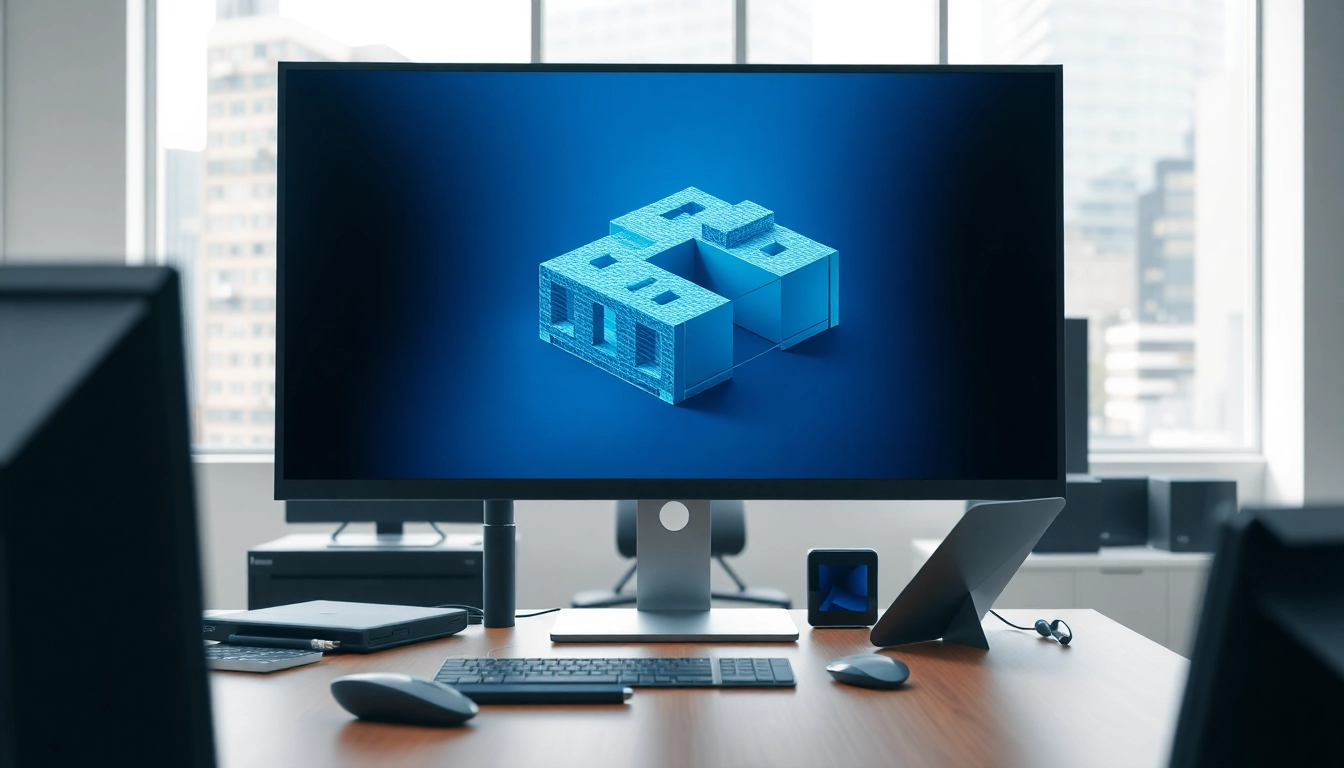Understanding 3D Model Visualizations
Definition and Importance
3D Model Visualizations are digital representations of three-dimensional objects, environments, or data, created using specialized software. This technology allows designers, architects, engineers, and other professionals to create, manipulate, and showcase products or concepts in a visually engaging manner. Utilizing 3D Model Visualizations elevates conventional presentations by providing dynamic views that static images can’t offer, thus enhancing communication and understanding.
Applications in Various Industries
3D visualizations have become essential tools across multiple industries:
- Architecture: Architects use 3D models to present building designs, allowing clients to visualize spaces before construction begins.
- Manufacturing: Engineers and manufacturers create detailed 3D models to prototype products, facilitating modifications before actual production.
- Medicine: In healthcare, 3D visualizations help in planning surgeries by providing detailed views of anatomical structures.
- Entertainment: The gaming and film industries rely heavily on 3D visualizations for character creation, environment building, and special effects.
- Education: Educational institutions use 3D visualizations to teach complex subjects, providing students with interactive models for enhanced learning.
Key Benefits of 3D Visualizations
The benefits of integrating 3D model visualizations into professional workflows are substantial:
- Improved Clarity: 3D models enable clearer communication of ideas and designs, reducing misunderstandings during the collaboration process.
- Enhanced Engagement: Interactive 3D visuals captivate audiences, making presentations more engaging than traditional slideshows.
- Cost Efficiency: By identifying potential design issues early through visualization, companies can save significant costs associated with changes late in the production process.
- Faster Decision-Making: Stakeholders can make informed decisions rapidly as they can visualize the end product, leading to quicker approvals.
- Competitive Edge: Companies that adopt cutting-edge visualization technology often stand out in their fields, attracting clients and partnerships.
Types of 3D Model Visualizations
Static Vs. Interactive Visualizations
3D model visualizations can primarily be categorized into static and interactive types:
- Static Visualizations: These are still images or animations of 3D models, providing a fixed perspective. They are commonly used in marketing materials, brochures, or presentations to convey a clear concept without interactive elements.
- Interactive Visualizations: These allow users to manipulate the viewing angle or zoom into details. This interactivity enhances user experience, especially in virtual showrooms or online product displays, giving potential buyers a sense of ownership before making a purchase.
Industry-Specific Visualizations
Different sectors tailor 3D visualizations to suit their particular needs:
- Architecture and Real Estate: Virtual walkthroughs allow clients to experience a property before it is built, influencing their layout and design preferences.
- Healthcare: Medical professionals use 3D models of organs or tissues to aid in diagnostics, surgical planning, and patient education.
- Automotive: Car manufacturers create detailed models to showcase vehicle features and designs during the pre-launch phase, enticing buyers with realistic visualizations of their products.
- Virtual Reality: In entertainment and gaming, 3D visualizations are vital for creating immersive environments. Developers can use these models to experience their creations interactively.
Emerging Trends in 3D Modelling
As technology evolves, new trends are shaping the future of 3D model visualizations:
- Augmented Reality (AR): Combining AR with 3D visualizations provides a more immersive experience, where users can see digital objects overlaid in their real-world environment.
- Real-Time Rendering: Advancements in graphics technology allow for real-time rendering of complex visualizations, making interactive experiences smoother and more engaging.
- AI-Driven Design: Artificial intelligence tools are emerging to analyze data and generate design solutions, enhancing the automation of 3D modeling processes.
- Sustainability Integrations: With growing concerns over environmental impacts, 3D visualizations are increasingly being leveraged to showcase sustainable designs and products, helping brands convey their ecological commitments.
Tools and Software for 3D Model Visualizations
Top Software Solutions
Several software programs dominate the industry for creating 3D model visualizations:
- SketchUp: Known for its user-friendly interface, SketchUp is ideal for architects and designers looking to create both simple and intricate models.
- Autodesk 3ds Max: This software offers a comprehensive set of modeling tools, enabling detailed visualizations that are commonly used in gaming and architecture.
- Blender: As an open-source option, Blender provides a robust platform for 3D modeling, animation, and even video editing, suitable for both beginners and professionals.
- Unity: More than just a game engine, Unity excels in real-time 3D visualizations and interactive simulations, frequently used in education and training environments.
- Maya: Preferred in the film industry, Autodesk Maya specializes in animation and character rigging, providing high-quality visual outputs.
Comparison of Features
When choosing a 3D visualization tool, several features should be considered:
| Software | User-Friendliness | Rendering Capabilities | Animation Tools | Collaboration Features |
|---|---|---|---|---|
| SketchUp | Easy | Basic | Limited | Good |
| 3ds Max | Moderate | High | Extensive | Moderate |
| Blender | Moderate | High | Extensive | Good |
| Unity | Moderate | High | Extensive | Excellent |
| Maya | Difficult | High | Extensive | Good |
Best Practices in Using 3D Tools
To ensure success in 3D model visualizations, consider these best practices:
- Start with a clear plan: Define the objectives and requirements of the visualization before commencing development to streamline the process.
- Utilize templates: Many software tools offer templates that can save time and enhance the consistency of visual presentations.
- Optimize models for performance: Keep file sizes manageable for smoother operation and faster loading times, especially when developing interactive content.
- Gather feedback: Regularly solicit input from stakeholders to ensure that the visualizations meet their expectations and modify based on feedback.
Creating Effective 3D Model Visualizations
Planning Your Visualization
Effective planning is crucial for producing compelling 3D visualizations:
- Identify your audience: Understand who will view the visualization and tailor the content to meet their interests and technical comprehension.
- Define your goals: What message should the visualization convey? Clarity in purpose will lead to more impactful designs.
- Gather relevant data: Collect data and resources, including drawings, specifications, and references, that will inform and enrich the visualization.
Designing for Audience Engagement
To capture and retain the audience’s attention, a few design strategies may be considered:
- Incorporate interactivity: Allow users to engage with the visualization through clickable elements or animations that enhance exploration.
- Utilize storytelling techniques: Create a narrative around the visual elements that guides users through the experience, bringing the model to life.
- Ensure aesthetic appeal: Use appropriate color schemes, textures, and lighting to enhance the visual experience, maintaining professionalism while being pleasing to the eye.
Iterating for Feedback and Improvement
Iteration is key in the creative process for 3D visualizations:
- Conduct reviews: Schedule regular review sessions with stakeholders to gather diverse perspectives and refine the visualization based on their suggestions.
- Test usability: Ensure that interactive elements work seamlessly; perform user testing to gauge how audiences interact with the visualizations.
- Be open to change: Adapt and pivot your approach based on feedback to develop a more effective final product.
Performance Metrics and Analytics
Evaluating the Impact of 3D Visualizations
Understanding the effectiveness of your 3D model visualizations can be measured through various metrics:
- User Engagement: Analyzing user interaction metrics, such as time spent on the visualization and click-through rates, can reveal how well the audience is engaging with the content.
- Conversion Rates: Tracking how visualization impacts decision-making processes or purchasing behavior provides insight into its effectiveness as a marketing tool.
- Feedback Ratings: Collecting qualitative data from users through surveys can help gauge satisfaction and areas for improvement.
Using Data to Enhance Visual Strategies
Incorporating data into visual strategies helps in building a more targeted and successful visualization:
- Analyze user behavior: Utilize web analytics tools to understand how users interact with visual content and identify patterns.
- Benchmark against competitors: Reviewing competitor visualizations can provide insights into industry standards and expectations that can be adapted to improve your own visualizations.
- Utilize A/B testing: Experiment with different visual styles or formats to determine which version resonates more effectively with audiences.
Case Studies of Successful Implementations
Examining case studies of successful 3D model visualizations can yield valuable lessons:
- Case Study 1 – Real Estate Development: A prominent real estate company utilized interactive 3D model visualizations to give potential buyers virtual tours of properties under development. This approach boosted pre-sales by 40% as clients could visualize their future homes even before construction.
- Case Study 2 – Automotive Marketing: A leading car manufacturer integrated high-quality 3D visualizations into their online platforms, allowing customers to customize and explore models. This interactivity led to a 25% increase in online engagement and higher test-drive bookings.
- Case Study 3 – Medical Training: A medical institution adopted 3D visualizations for training purposes, creating detailed models of human anatomy. This innovation significantly improved student comprehension and retention rates, resulting in a 30% increase in exam scores among participants.



